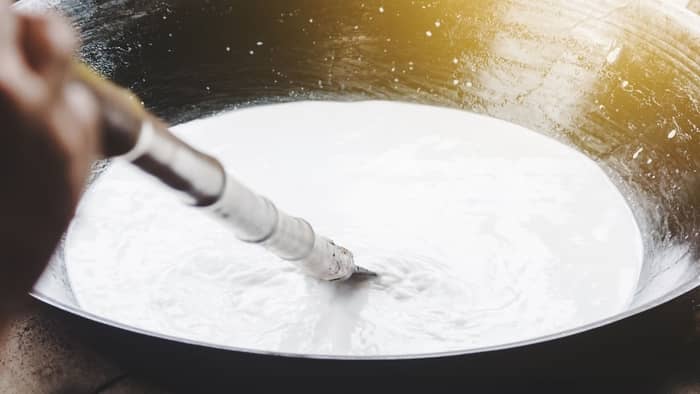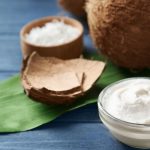Last Updated on February 5, 2023
Wondering how to thicken coconut milk as cream? We have the best tips and tricks for you to achieve this. You won’t believe how easy it is to make it.
I mean, who doesn’t like coconut milk? It’s delicious! These step-by-step guides will save your life in case you need to make homemade coconut cream, or you just feel like making it from scratch. And ultimately, you’ll want to always make it at home instead of buying it at the store, I’m sure!
We will also show you how to make a dairy-free vegan whipped cream. Check it out!
What is Coconut Cream?
Coconut cream from coconut milk… more than mouth-watering!
Coconut cream is like pastry cream; a sweet preparation with which we can fill any dessert or simply serve as an accompaniment. It is a very easy-to-make recipe, and for those who enjoy the flavor that this tropical fruit provides, it is a delight.
Certainly, this coconut cream makes you want to eat it by the spoonful, but let’s resist and make a dessert with it; it will surely be worth it. Coconut cream is very similar to coconut milk but contains less water, the difference is mainly about consistency. It has a thicker and paste-like texture, while coconut milk is usually creamy but liquid.
In other words, coconut cream is used to cook many salty and sweet dishes and it has a mild non-sweet taste. In the next paragraphs, you’ll see the step-by-step guide on how to make cream of coconut the easiest way and also, preserve the coconut flavor.
There are plenty of recipes out there on how to thicken coconut milk and make cream out of it. We found some good ones and we are now giving you the best ones in one post. Of course, we’ve tried them already.
Here you have 3 simple ways of making your coconut cream.
How to Thicken Coconut Milk Step-By-Step
Guide #1: Thickening With Cornstarch
Cornstarch is a white powder, with a much silkier and finer texture than flour, and is mainly used as a thickener. It is an essential ingredient in cooking: it is used to make light doughs, thicken soups, and make sauces, among other culinary uses.
This preparation has a simple name, it is called Slurry.
Equipment
- a small mixing bowl
- a medium mixing bowl
- a fork
- a hand whisk
- a saucepan
- a fine strain
Ingredients
- 1 cup of coconut milk
- 1 tbsp of cornstarch
- 2 tbsp of water
Step-by-Step Directions
Step #1: Make Your Slurry
First, grab a small bowl and mix the water and the cornstarch. You can use a fork to mix them until combined.
Cuisinart 719-18P Chef’s Classic Stainless 2-Quart Saucepan with Cover, Silver
Step #2: Mix and Stir
Grab a saucepan, pour your coconut milk, and simmer to low heat. Add the slurry and stir. Do not stop stirring until you see that it slowly thickens.
Patience is the key.
Step #3: Strain
Once your coconut cream has thickened, remove it from the heat. Strain your cream with a fine strainer over a bowl or container.
Step #4: Let it Cool
Let it cool at room temperature.
Another tip: if you want it to be a little sweeter, add 1/2 teaspoon of icing sugar to the mixture before you strain it.
Guide #2: Reducing Your Coconut Milk
Reducing sauces in the kitchen is very simple, but it also requires patience and attention. Coconut milk will thicken naturally when the water it contains slowly begins to evaporate. Check it out.
Equipment
- a large saucepan
- a hand whisk
- a fine strain
- a medium bowl
Ingredients
- 1 cup of coconut milk
- sugar to taste
Step-by-Step Directions
Step #1: Let it Boil
Bring the coconut milk to high heat. You’ll notice small bubbles once it starts to boil. Then, lower the flame to low heat. Continue stirring.

Step #2: Strain
Once your coconut cream has been reduced, remove it from the heat. Strain your cream with a fine strainer over a bowl or container.
Step #3: Let it Cool
Let it cool at room temperature before using it, or use it immediately if you’re cooking a warm dish.
Guide #3: Make Coconut Cream From Coconut Meat
This is definitely not as easy as the first two guides we already told you about, however… its way of making it from scratch – with coconut meat instead of milk – is the richest way of doing it. Try it and let us know what you think.
You should try all of these and compare! I assure you that you won’t want to buy it again and you’ll want to make your own coconut cream at home from now on.
Equipment
- a deep saucepan or casserole
- a spatula
- a cheesecloth
- a medium mixing bowl
- a cheese greater
Ingredients
- 4 cups of coconut meat, shredded
- 1 cup of water
- sugar to taste
Step-by-Step Directions
Step #1: Shred Your Coconut Meat
Start by shredding your coconut meat.
Step #2: Boil
Grab your saucepan or casserole pot and pour the water and the shredded coconut meat into it at high heat. Let it boil and turn off the flame.
Step #3: Let it Cool
Remove from heat and let it cool at room temperature.
Step #4: Strain
Once is completely cool, sift the mixture with cheesecloth and press it with your hands to remove any excess liquid. You’ll notice your milk being thicker than the store-bought milk, so this is a good sign. Set aside.
Step #5: Let it Sit and Separate
Let it sit at room temperature and away from sunlight. Keep it in a cool place. In about an hour or so, you’ll notice a layer of coconut cream floating and rising to the top. Voilà!
Making Coconut Whipped Cream
This video will show you how to make dairy-free vegan whipped cream from canned coconut milk, you can use your homemade coconut milk also. I hope you like it!
Other Ways of Thickening Coconut Milk
There are many ways of thickening coconut milk. While we’ve already looked at the most common ways to thicken coconut milk, there are a few more you may like to try; particularly if you don’t have the ingredients for the methods listed above.
Using Potatoes
The use of potatoes is great if you’re looking for a slightly less sweet version of coconut milk. To do this, all you need to do is:
- Bring a saucepan of water to a boil over medium heat.
- While the water is boiling, peel your potatoes and add them to the boiling water.
- Reduce heat and cook until the potatoes are fork-tender. Once tender, mash the potatoes.
- Using the water from your saucepan, make a slurry with your mashed potato. Mix well and then add to your coconut milk.
- Mix well and your thickened coconut milk is ready!
Using Coconut Flour
The use of coconut flour is ideal if you’re looking to enhance the coconut flavor of your coconut milk. As they’re both made from coconut, the flavors complement each other really well. To do this, all you need to do is:
- Add your coconut milk to a saucepan and warm over medium heat.
- Once warm, remove around 1/2 cup of the milk and add around a tablespoon of coconut flour. Mix well to make a smooth slurry.
- Now you can pour the slurry back into the saucepan of coconut milk. Bring to a boil and then remove from heat. Use as needed!
Why is My Coconut Milk Lumpy?
You may be wondering if your coconut milk is okay if you open it and find lumps or chunky pieces. With cow’s milk, this would typically mean that it had curdled and was unsafe to eat, but that is not the case with coconut milk. Coconut milk is supposed to be lumpy and thick when opened. This is because it’s very high in fat. Once opened, the mixture will separate, and the creaminess will take over.
However, if there is a sour smell or the coconut milk doesn’t look as it should, you should discard it immediately, as it has likely gone bad.
Does Coconut Flour Thicken?
Absolutely! All types of flour work well as thickening agents, including coconut flour. You can use coconut flour to thicken many foods, such as sauces and soups. It’s worth mentioning that if you don’t like the taste of coconut, you should try another flour alternative to thicken your foods.
What is Coconut Milk Used For?
Coconut milk can be used for a selection of baking and cooking recipes. Here are some of the top ways you can incorporate coconut milk into your kitchen.
- soup: a substitute for any liquid
- curries and stews: adds a creamy texture
- whipped cream: makes for a perfect topping on desserts
- drinks: smoothies and coffees are great when coconut milk has been added
- ice cream: coconut milk can make your ice cream super smooth, creamy, and rich
- vegan alternative: many people have now chosen the vegan lifestyle, and coconut milk is a perfect vegan substitute for cow’s milk
Final Words
I hope you’re now familiar with how to thicken coconut milk. And please feel free to ask if you have any questions, we’ll always be happy to help. Do you have any tips or tricks when it comes to thickening coconut milk? If so, please feel free to let me know in the comments below.
Cheers to all my keto friends out there!
How to Thicken Coconut Milk: Incredible Recipe With 3 Effective Methods
Equipment
- a small mixing bowl
- a fork
- a hand whisk
- A saucepan
- a fine strain
Ingredients
- 1 cup of coconut milk
- 1 tbsp of cornstarch
- 2 tbsp of water
Instructions
- Make your slurry. First, grab a small bowl and mix the water and the cornstarch. You can use a fork to mix them until combined.2 tbsp of water, 1 tbsp of cornstarch
- Mix and stir. Grab a saucepan, pour your coconut milk and simmer to low heat. Add the slurry and stir. Do not stop stirring until you see that it slowly thickens.Patience is the key.1 cup of coconut milk
- Strain. Once your coconut cream has thickened, remove it from heat. Strain your cream with a fine strainer over a bowl or container.
- Let it cool at room temperature.



